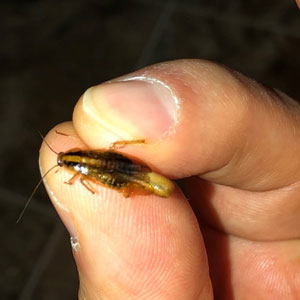
German cockroach female with egg case (oothecal). Photo: Dr. Mohammed El Damir, BCE
German cockroaches (Blattella germanica) are small, light brown to tan insects that have two dark parallel stripes running down their backs. They have long antennae, wings and six legs. Adults can range in size from 1/2 to 5/8 inch in length, with a flattened, oval-shaped body. German cockroaches have a distinctive appearance that sets them apart from other cockroach species. Their smaller size and light brown coloration, combined with the two dark stripes on their backs, make them easily recognizable. It is important to note that German cockroaches can be mistaken for other types of small insects, such as beetles or crickets. However, if you get a closer look, you can usually identify them by their distinctive features, such as their flattened bodies, long antennae, and rapid scurrying movements.
German cockroaches are believed to have originated in Africa, but they are now found throughout the world. They are thought to have been spread to other parts of the world through human trade and transportation, such as on ships or in cargo. German cockroaches are now one of the most widespread species of cockroaches, found in many different types of buildings, including homes, restaurants, hospitals and other commercial buildings. They are well adapted to living in human environments and have been able to successfully colonize many parts of the world due to their ability to adapt to new environments and their high reproductive rate.
German cockroaches are considered serious pests because they can rapidly infest a building and cause a wide range of health problems. They are very resilient and can survive in many different environments, which allows them to quickly spread and reproduce. Some of the reasons why German cockroaches are considered pests include:
- They can carry diseases: German cockroaches can carry bacteria, viruses and other pathogens that can cause illnesses in humans. These pests can contaminate food and surfaces with their feces and saliva and also shed skin.
- They can trigger allergies: German cockroaches produce allergens that can cause asthma and other respiratory problems in some people. These allergens can be found in their feces, saliva and body parts.
- They can damage property: German cockroaches can chew on and contaminate paper, fabric and other materials, causing damage to books, clothing and furniture.
- They reproduce quickly: German cockroaches have a short reproductive cycle and can produce large numbers of offspring in a short period.
- They are difficult to eradicate: German cockroaches are very resilient and can survive in harsh conditions. They can also quickly develop resistance to pesticides, making them difficult to eliminate once they have established a presence in a building. Besides, their limited mobility can make it difficult for baits and pesticides to reach them.
- German cockroaches can develop resistance to certain pesticides over time, further complicating control efforts.
- German cockroaches have high levels of resistance to certain types of bacteria and endotoxins due to a combination of several factors, including their cuticle properties, detoxification enzymes, and microbial symbionts. These adaptations enable them to survive and thrive in environments that would be toxic to other organisms. Their impermeable cuticle helps prevent the entry of certain chemicals and toxins, including endotoxins, into their bodies. Additionally, their detoxification enzymes can break down and neutralize harmful substances, which allows them to tolerate and survive exposure to toxins and bacteria. Moreover, the symbiotic microorganisms living in their guts can aid in the detoxification process, further enhancing their resistance to harmful substances.
In Part II of this series, we will explore best practices for controlling and preventing German cockroaches using the concept of integrated pest management, or IPM.
Leave A Comment